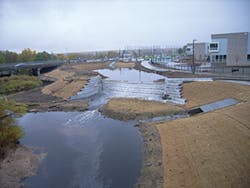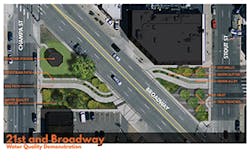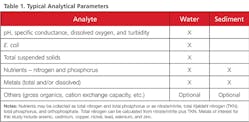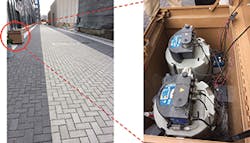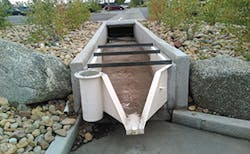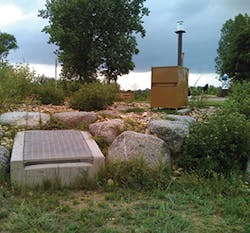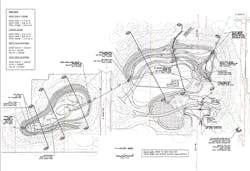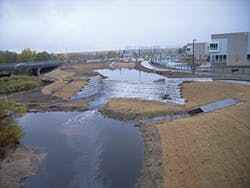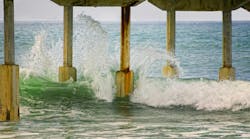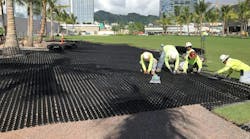For several years, the City and County of Denver has implemented programs intended to improve the quality of water discharged from City-owned stormwater infrastructure into the streams and lakes in Denver. These efforts have been implemented in accordance with Denver’s municipal separate storm sewer system (MS4) discharge permit and to support compliance with an E. coli total maximum daily load (TMDL) on the South Platte River. Activities include infrastructure maintenance, stream and lake restoration, installation of stormwater quality control measures, and education and outreach. More recent efforts have focused on green infrastructure and end-of-pipe treatment. Green infrastructure is becoming increasingly important for stormwater management in Denver, especially as real estate values rise and opportunities for more traditional stormwater quality control measures are constrained by a lack of space. Installation of stormwater quality control measures is guided by Denver’s Green Infrastructure Implementation Strategy (Denver Public Works 2018), which identifies the City’s priorities, explores opportunities, and describes treatment options. The strategy also provides an overview of monitoring and research intended to assess the effectiveness of stormwater control measures that will be implemented in several upcoming redevelopment projects in Denver.
The costs of designing, constructing, and maintaining green infrastructure control measures are not inconsequential, and as a result, Denver is interested in maximizing control measure performance. To better understand factors that affect performance, Denver developed a stormwater quality control measure monitoring plan. The goals of the plan are to 1) assess the effectiveness of control measures; 2) determine how land use, imperviousness, plant selection, and other factors influence control measure performance; and 3) understand maintenance needs. The plan describes monitoring strategies intended to provide data that will help Denver better understand which control measures are most effective, what factors are important to consider during control measure design to maximize performance, and when maintenance is needed. Implementation of the plan began during the fall of 2018.
This article provides an overview of Denver’s monitoring program and the decision-making process for monitoring site selection. Denver’s experience may be useful to other cities considering monitoring stormwater quality structural control measures in their communities.
The Case for Monitoring Green Infrastructure
Many local governments and universities conduct performance monitoring for urban structural control measures. The purpose of those studies is to better understand the factors that affect control measure performance and in some cases to comply with stormwater discharge permit requirements. Control measure performance data are available from the International Stormwater Best Management Practice (BMP) Database (www.bmpdatabase.org), a compilation of nearly 680 control measure performance studies. In Colorado, the Urban Drainage and Flood Control District, the City of Fort Collins, and others have monitored various types of structural controls; however, monitoring data sets for green infrastructure practices remain relatively limited. Bacteria data sets, which are of particular interest to Denver, are limited nationally for most types of structural controls.
Meta-analysis of the performance studies in the BMP Database conducted by Wright Water Engineers and Geosyntec (2017) demonstrates that structural control measures can be effective at reducing pollutant loading and that many factors can affect performance. Those factors include design, installation, and maintenance practices, as well as tributary watershed characteristics and site conditions. In addition, each type of control measure has different treatment processes (e.g., sedimentation, filtration, infiltration, biological processes) that may be better for reducing concentrations and/or loads of certain pollutants. As a result, there are many variables that can affect the effluent concentrations and surface volume runoff reduction achieved by control measures.
Given the range of factors influencing performance of green infrastructure structural control measures and the relatively limited information specific to Colorado, the City and County of Denver decided to collect performance data to determine the effectiveness of structural control measures installed in Denver. Because the cost of designing and building green infrastructure control measures can be high, there is value in verifying that control measures are functioning as intended and understanding the elements that contribute to control measure performance and maintenance needs. Developing an understanding of these factors will allow Denver to design and install cost-efficient control measures that provide the appropriate stormwater quality protection for each setting and to efficiently maintain control measures so that they function as intended throughout their life cycles.
Development of a plan that describes Denver’s monitoring efforts was completed in early 2018. The plan describes efforts to evaluate control measures installed by Denver’s Department of Public Works to ensure they are effective at improving water quality and to provide information that can be used to optimize control measure design and installation.
Green Infrastructure in Denver
Denver has made green infrastructure an important part of its stormwater management strategy and has been considering ways to incorporate green practices for stormwater quality into regional, subregional, and site-scale projects. The primary goal of Denver’s Green Infrastructure Program is to help improve water quality and reduce flooding risks. It also provides benefits for air quality, urban heat island mitigation, climate change resiliency, and community livability.
The City’s Green Infrastructure Program has developed guidance on the implementation of green infrastructure in ultra-urban settings (DPW 2016) and a strategy for the implementation of green infrastructure citywide (DPW 2018). The implementation strategy describes priorities and opportunities for use of green infrastructure in Denver. Design and construction of several structural control measures described in the implementation strategy is either complete or underway. Examples of some of these projects are shown in Figures 1 and 2.
An Overview of Denver’s Monitoring Plan
Denver’s Stormwater Quality Control Measure Monitoring Plan describes how data are collected to assess the effectiveness of selected stormwater quality control measures. Data collection includes sampling and analysis of stormwater runoff and sediment and measurements of flow. Monitoring results are used to answer the following questions:
- How effective are specific types of structural control measures at removing pollutants?
- How does drainage basin land-use (e.g., ultra-urban, residential, industrial) and imperviousness influence control measure performance?
- How does changing specific design elements (e.g., engineered media, vegetation types) factor into the effectiveness of structural control measures?
- How does the presence of a structural control measure (or structural control measures) in a storm drainage basin impact the quality of stormwater discharged at the basin outfall?
- How frequently are various types of control measure maintenance needed?
The monitoring plan includes sections that describe data needs, monitoring strategies, sampling protocols, and analysis of collected data.
Monitoring Strategies. The plan describes monitoring strategies specific to the type of stormwater quality control measure being evaluated. Strategies include:
- Monitoring of regional and site-scale structural control measures with well-defined inflows and outflows will be conducted with paired automated sampling equipment during storm events to determine their effectiveness at improving water quality and reducing runoff peaks and volumes.
- Monitoring results from structural control measures without a well-defined inflow will be compared to control watersheds to determine their effectiveness. Control watersheds will be selected to ensure that drainage basin characteristics, land-use patterns, imperviousness, basin size, and other key characteristics are similar to those for the structural control(s) being evaluated.
- The effectiveness of structural control measures that treat smaller areas will be evaluated using simulated runoff tests.
- Selected storm drainage basin outfalls will be monitored during storm events to determine the cumulative impact of all structural control measures installed in the basin.
- Sediment samples will be collected from a limited number of site-scale structural controls to better understand how each control measure is performing and to inform design of other structural controls. Sediment data will be used to evaluate accumulation of pollutants in the upper soil layers of control measures and will also be useful for understanding when control measure maintenance is needed.
- Infiltration rates will be measured for infiltration-based structural control measures to better understand performance and required maintenance frequencies.
Monitoring Details. Monitoring data will generally follow the reporting protocols associated with the International Stormwater BMP Database, including metadata for the watershed and control measure characteristics, precipitation, runoff rates and volumes, and water chemistry (Table 1). Additionally, Denver is interested in characterizing the physical and chemical properties of sediment accumulated in stormwater control measures. Maintenance activities and source control measures in the tributary watershed will also be documented during the monitoring period.
Sampling of targeted storm events will be conducted between April and October of each year. The goal is to collect samples from each structural control measure and outfall at least three or four times a year; however, the number of sampling events is dependent on weather conditions. During drought years, it may not be possible to collect three or four samples in Denver.
Denver will target sampling targeted storm events between 0.2 and 0.6 inch of precipitation (0.6 inch of precipitation is used to calculate the water-quality capture volume in Denver). Samples also may be collected from larger or smaller events if information from those events is determined to be of value. For sites where simulated runoff tests are conducted, quarterly testing is planned. Infiltration testing and sediment sampling will be conducted annually for selected sites.
It is anticipated that water-quality sampling will be conducted at three to four structural control measures at the same time. For some measures, it may also be necessary to study a control watershed to assess effectiveness. Control watersheds will be selected to ensure that drainage characteristics, land-use patterns, imperviousness, size, and other key characteristics are similar to those for the structural control being evaluated.
Control Measure Configuration. The project team developed plans to ensure that all new structural control measures are designed and installed with features that allow for easy placement of sampling equipment after construction is complete. Figure 3 is an example of a typical detail provided to contractors to ensure stormwater quality control measures are designed and built with the structures needed for sampler placement. The details, which can be modified for incorporation into plans for any control measure, are intended to ensure control measures are built ready for accurate flow measurement and for water-quality sample collection. They are also expected to reduce costs associated with control measure monitoring by minimizing the need for modifications to accommodate sampling equipment.
Sampling will be conducted using automated samplers installed in secure locations at each control measure. An example of an automated sampler setup is shown in Figure 4. The sampler is programmed to collect samples when precipitation occurs and there is an increase in flow through the control measure. Samples are collected through tubing that runs from the sampler to the control measure. Discharge from the tubing is collected in a sample container (or containers) stored in the lower portion of the sampler.
Putting All the Pieces Together
Although Denver’s sampling efforts are just beginning, monitoring of other green infrastructure control measures in the Denver area can be used to illustrate what Denver’s sampling program will look like. Figure 5 shows the inlet to a bioretention basin that treats runoff from a parking lot before discharge to the South Platte River. The inlet to the bioretention basin passes through an H flume, which is instrumented with a flow meter. The H flume ensures that accurate flow measurements can be collected during sampling. At the upstream end of the flume is a port through which samples are collected by the automated sampler. The sampler, which collects flow-weighted composite samples, is housed in a secure location near the control measure in an area that is unlikely to flood during storm events. Sampling is triggered by flow in the flume and precipitation recorded by a nearby rain gage. Flow measurements are collected using a bubbler or Doppler flow meter, and precipitation measurements are collected using a rainfall tipping bucket (Figure 6).
Monitoring Concerns and Lessons Learned
Although Denver’s efforts to assess the effectiveness of its stormwater quality control measures are relatively new, staff have already learned several important lessons.
As with any sampling plan, an upfront consideration of sampling goals is important to ensure that monitoring efforts collect the data needed to answer monitoring questions. Denver chose to develop our monitoring plan following EPA QAPP guidance (USEPA 2002) to ensure we are collecting the data needed to adequately answer monitoring questions. The QAPP guidance provides a step-by-step process in which users carefully consider and create monitoring objectives. The monitoring objectives are then used to develop monitoring strategies and data analysis techniques to ensure that the collected data provide information that can be used to assess against plan objectives.
Early in the process of developing a monitoring plan, it became apparent that collecting accurate flow measurement from stormwater quality control measures during storm events is a challenging task. The project team learned that careful consideration must be given to each control measure to ensure it is designed to allow accurate collection of flow data, especially at lower flows. To address this issue, typical construction details were developed to ensure that new stormwater quality control measures are configured to allow accurate collection of flow data and can easily be instrumented for monitoring. An example of a typical detail is shown in Figure 3. The details also ensure that control measures are built sampler-ready and save costs by eliminating the need to retrofit each measure for the installation of stormwater quality monitoring instrumentation.
Two examples illustrate some of the complications with monitoring flow data accurately. Figure 7 is the design for a bioretention basin, which will be monitored after construction is complete. Inflows enter the basin from the north (north is to the left of the image) and from the west. Stormwater runoff entering the control measure from the south has limited retention and treatment time before discharging to the storm sewers at the outflow of the control measure. Because retention and treatment is not similar to the northern portion of the control measure, it is difficult to understand if the control measure is effective at improving water quality. As a result, only the northern portion of the basin will be monitored.
The second example, shown in Figure 8, is an extended detention basin with a permeable bottom. Initial plans called for monitoring of this control measure; however, it is at the bottom of a stormwater drainage basin and drains directly into Cherry Creek, shown in the foreground of the photo. Because the control measure is close to the receiving waters, hydraulics at the outflow are affected by the water elevation in the creek. Since the relationship between depth and flow rate at the outfall is not singular, it would be difficult to determine whether samples collected from the underdrain were treated stormwater, alluvial groundwater, or inflows from the creek. As a result, the control measure shown in Figure 8 is not suitable for sampling.
Although Denver developed typical details for sampler setup for stormwater quality control measures, each control measure is uniquely configured and, as a result, site-specific sampling plans are necessary for each measure. Site-specific sampling plans provide information on flow monitoring, sampler configuration, analytical suite, and other factors that are important for sampling a control measure. Denver has developed site-specific monitoring plans for two sites including the site shown in Figure 1 and will be developing plans for the sites shown in Figures 2 and 7.
Field measurements of pH, specific conductance, temperature, dissolved oxygen, and turbidity can be difficult to collect using automated equipment due to potential fouling of probes, concerns with vandalism, the need for frequent recalibration and maintenance, and other factors. Denver opted not to use a continuous recorder for this information due to these factors. Maintaining calibration of these instruments is much more labor intensive than for a flow meter.
Denver began stormwater control measure performance monitoring in 2018 and will expand efforts to several additional sites in 2019. The information collected by the monitoring program will advance local understanding of control measure performance and will be submitted to the International Stormwater BMP Database. The information will not only be valuable locally, but will also help to further develop the national understanding of green infrastructure performance in semi-arid climates.
Acknowledgements
Monitoring efforts described in this article would not have been possible without support from staff and management at Denver’s Department of Public Works. Technical assistance in the development of typical details and monitoring and site-specific sampling plans was provided by Wright Water Engineers, TriHydro Corporation, and Wilson and Company.
References
Denver Department of Public Works. 2016. The City and County of Denver Department of Public Work Ultra Urban Green Infrastructure Guide. Available at www.denvergov.org/content/dam/denvergov/Portals/705/documents/guidelines/PWES-013.0-Ultra_Urban_Green_Infrastructure_Guide.pdf.
Denver Department of Public Works. 2018. Green Infrastructure Implementation Strategy. Available at www.denvergov.org/content/denvergov/en/wastewater-management/stormwater-quality/green-infrastructure.html.
International Stormwater Best Management Practice Database. 2018. www.bmpdatabase.org. Accessed on 4/23/18.
USEPA. 2002. Guidance for Quality Assurance Project Plans, EPA QA/G-5. Office of Environmental Information. EPA/240/R-02/009. Available at www.epa.gov/sites/production/files/2015-06/documents/g5-final.pdf.
Wright Water Engineers Inc. and Geosyntec Consultants. 2017. International Stormwater Best Management Practices (BMP) Database: 2016 Summary Statistics. Prepared through support from Urban Drainage and Flood Control District and City and County of Denver. Water Environment Research Foundation: Alexandria, VA. Accessible at www.bmpdatabase.org.
